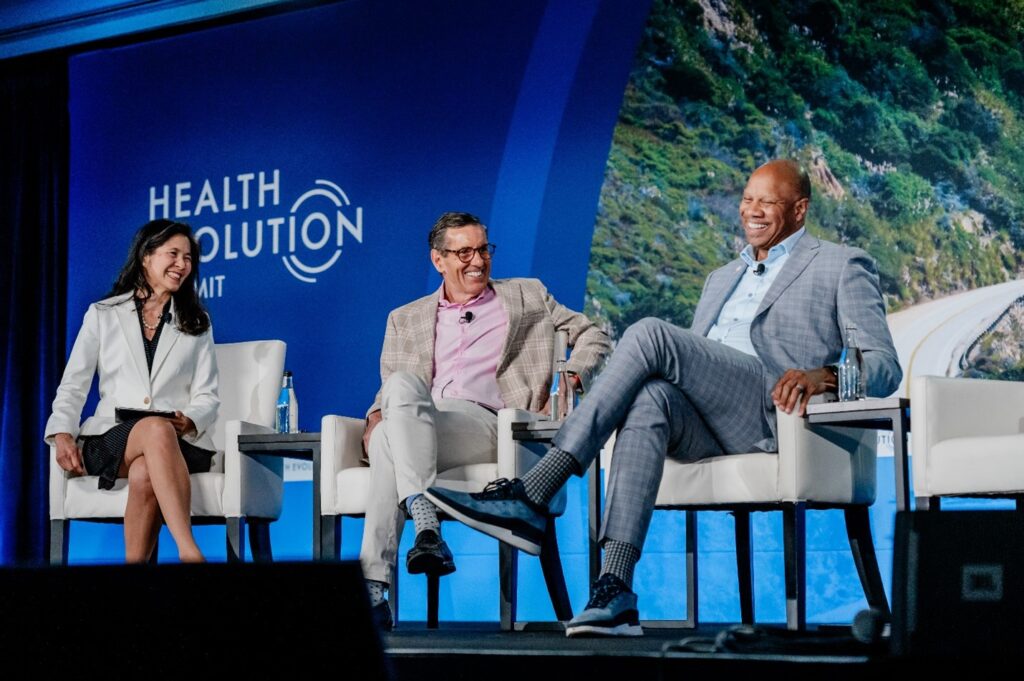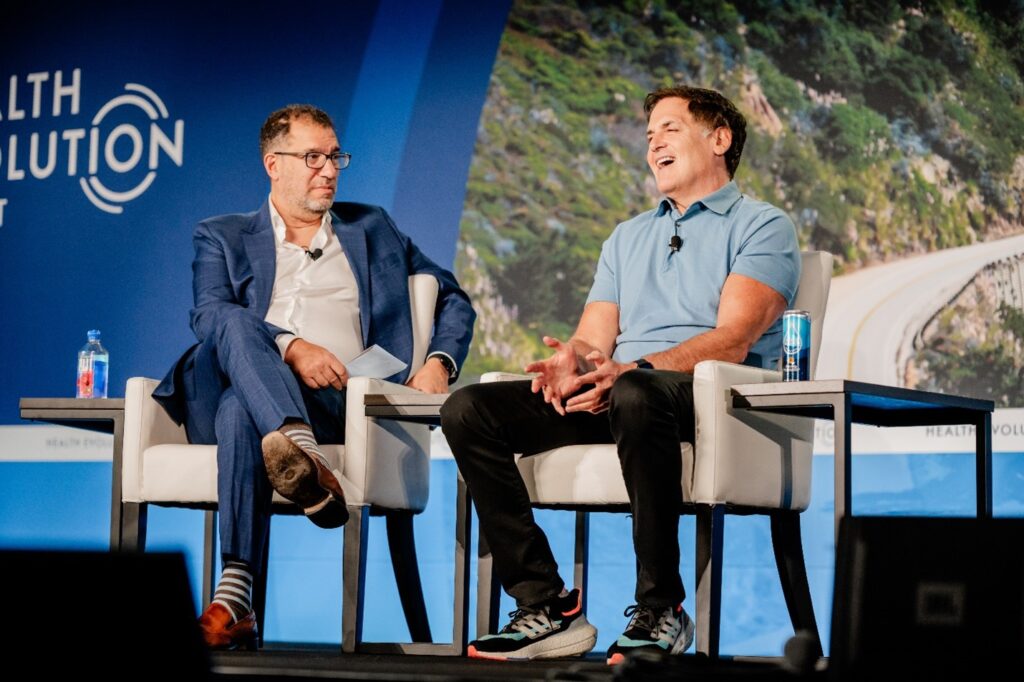Each year, Health Evolution Summit brings together an unparalleled community of influential CEOs from health systems, health plans, and life sciences companies, plus select policymakers, investors, retailers, and technology leaders, to examine the most top-of-mind issues and opportunities facing the industry. This mix of the industry’s most prominent leaders allows participants to have candid and cross-industry dialogue that sets the agenda for CEOs for the year ahead.
At our 2024 Summit in April, executives kicked off with a powerful focus on visionary leadership. They explored the courage, resilience, and conviction required to navigate the health care landscape in conversations led by groups of accomplished and inspiring leaders, including:
- Bruce Broussard, CEO, Humana;
- Mark Cuban, Entrepreneur & Co-Founder, Mark Cuban Cost Plus Drug Company;
- Alexandra Drane, Co-Founder & CEO, ARCHANGELS;
- Audrey Gregory, PhD, EVP & CEO of AdventHealth East Florida Division;
- Mary Langowski, EVP & President, U.S. Healthcare, Walgreens Boots Alliance;
- Wright Lassiter, III, CEO, CommonSpirit Health;
- Lisa Shannon, President & CEO, Allina Health;
- Andy Slavitt, General Partner, Town Hall Ventures; Former Senior Advisor to the Biden Administration COVID Response; Former Acting Administrator, Centers of Medicare and Medicaid Services; and Host, In the Bubble with Andy Slavitt; and
- Phoebe Yang, Board Director of GE Healthcare, Doximity, and CommonSpirit Health; former General Manager, Amazon Web Services.
Read on for their insights to empower resilient leadership and drive impactful change in health care.
Our Leadership Moment: The Call for CEO Courage Amid Turbulent Times

During a conversation entitled “Our Leadership Moment: The Call for CEO Courage Amid Turbulent Times,” moderator Yang and discussion leaders Broussard and Lassiter candidly explored how leaders find the courage to make hard choices both within their organizations and on the national stage, as well as how executives can navigate challenges to become bold and courageous leaders.
They acknowledged that today’s CEOs face no shortage of challenges, ranging from health care disparities to regulatory uncertainty and to the newfound prominence of AI. At the same time, leaders must contend with a host of hot-button societal issues—geopolitics, climate change, violence in our communities, and the politicalization of health care.
While today’s landscape can feel tumultuous, Lassiter pressed leaders to let their organizations’ missions guide them in when and how to address emerging challenges. “You can’t speak to every issue every day all the time. And so you have to think about what issues align well with the purpose, vision, and values of your organization. You have to think strategically around how you deliver messages that align with what your organization thinks are important and that you feel passionate about as a human being,” he said.
Broussard offered similar advice. “It’s important to have an ecosystem around the purpose, the culture, the business model, the strategy, including capital deployment, of your organization. Having that ecosystem at the center allows your conversation to be consistent, reduces the penetration of distractions, and makes it easier for you to manage the external and internal sides of the equation,” he said.
Broussard added that leaders should “focus on areas where their organizations can speak up with some permission and expertise.” He explained, “Align your purpose with your ability to help people achieve their best health in a way that your organization has some expertise and that can help the community. It’s less about politics and much more around where the organization has the ability to help the community with the skills and knowledge that you have.”
Yet even when following your organization’s mission, it can be difficult for executives to make hard decisions. To that end, Lassiter said leaders should follow their instincts on what’s best for their organizations and the people they serve. “I think, oftentimes, decisions seem challenging in the moment, but when you look back, you decide that it really wasn’t that hard of a decision because it was the right thing. And so the right decision, in my mind, is never a hard decision. There may be circumstances around it that are challenging, but the actual decision itself isn’t hard,” Lassiter said.
Lassiter also recommended that executives consider how they can “reduce the gap” between where their organizations stand today and what’s possible for their future. “Think about what’s the best your organization could be and how far away the organization is from that ideal. Your job is to get closer every day. That doesn’t mean you have to have monumental or transformational impact tomorrow, but you ought to be on that path and put forth all of your effort to try to reach that point,” Lassiter said.
Health Care in the Hot Seat: Fireside Chat with Mark Cuban

During a conversation entitled “Health Care in the Hot Seat: Fireside Chat with Mark Cuban,” Cuban talked further with Slavitt about how to lead courageously in health care.
Specifically, Cuban encouraged executives to lead bold change in the industry by increasing price transparency, which is a key tenant both to the Mark Cuban Cost Plus Drug Company’s business and how Cuban approaches health care costs for his own employees. “If companies act in their own self-interest and ask for transparency, ask for all their claims on a daily basis, ask for an open formulary, ask for no rebates and lower deductibles and lower copays, the industry will have to change its behavior,” Cuban said. He continued, “Customers control the world. When you don’t negotiate the best prices possible, it’s your employees and your company’s bottom line that suffer. That’s what’s at stake, and it’s really in your own control as a leader.”
But health care executives shouldn’t stop at price transparency if they want to their organizations to be successful, Cuban said. “The more transparent you can be about everything you do, the more trust you’re going to garner. And the more trust you garner, the better your business is going to be. I really think that trust is going to be the thing over the next five years that differentiates successful from non-successful businesses,” he said.
The Resilient Leader: Finding Fortitude, Achieving Sustainability, and Building Collective Resolve

Being a courageous leader takes resiliency. Executives must take care of themselves and those around them, while also navigating unrealistic expectations and double standards—especially for women and other underrepresented leaders. During our Confab for Advancing Women in Leadership Big Discussion, titled “The Resilient Leader: Finding Fortitude, Achieving Sustainability, and Building Collective Resolve,” moderator Drane and discussion leaders Gregory, Langowski, and Shannon shared reflections and guidance from their own experiences striving for resilience and sustainability, as well as how they are enabling resolve across their executive teams and organizations.
Shannon touted the need for work-life integration rather than the often-discussed concept of work-life balance. “An integrated life is necessary. There is no work life and no home life. There are moments of game face. You can’t show up with all of your worries of your family or life broadly in every moment, and yet you still can authentically talk about things in your home and work life that allow you to relate to the team,” she said.
Doing so can help to create an environment where leaders and employees feel supported and understood. It also can be a competitive advantage. “As an organization, you have to know what your soul is. What is the soul of the people you’re serving? How can you be soul-to-soul in every situation? When you do that, you get loyalty. You get retention. You get growing market share,” Drane said.
It’s also important for executives to encourage other leaders and employees to share their experiences, Langowski said. “It’s so simple to make people feel seen. You talk to people. You have town halls, survey them, ask them what they care about. Tell them that you also have stuff going on. When you share that you have stuff going on with your leaders, then they feel like they can share back with you and others,” she noted.
That openness can build a culture where employees and leaders alike feel safe at work—which ultimately could improve performance, the discussion leaders said.
“We have to create psychological safety for our team, which means we have to create venues where people in meetings, people in the halls, people in the operating room, can speak up,” Shannon said. “We have to pay attention to our wellbeing and the wellbeing of our teams. If we don’t get it right, we will not deliver the kind of care our communities deserve,” she added.
Gregory agreed. “In health care, we have a moral imperative to make sure that the people we care for are cared for in ways that are meaningful to them, so that they can go onto their best lives,” she said. And to do that, leaders and employees must feel like they have the support they need to do their best work in whatever role they hold, she noted.
But that can be tough, Gregory acknowledged, especially for people who are underrepresented in leadership or who are not yet leaders, themselves. “Particularly for people of color, I think it’s important for us to recognize that we have got to stop making ourselves smaller for other people to feel bigger. And sometimes that’s really hard, particularly if you’re coming from an employee perspective, but it’s important to grow where you’re planted and really understand that you can be incredibly impactful where you are,” Gregory said.










